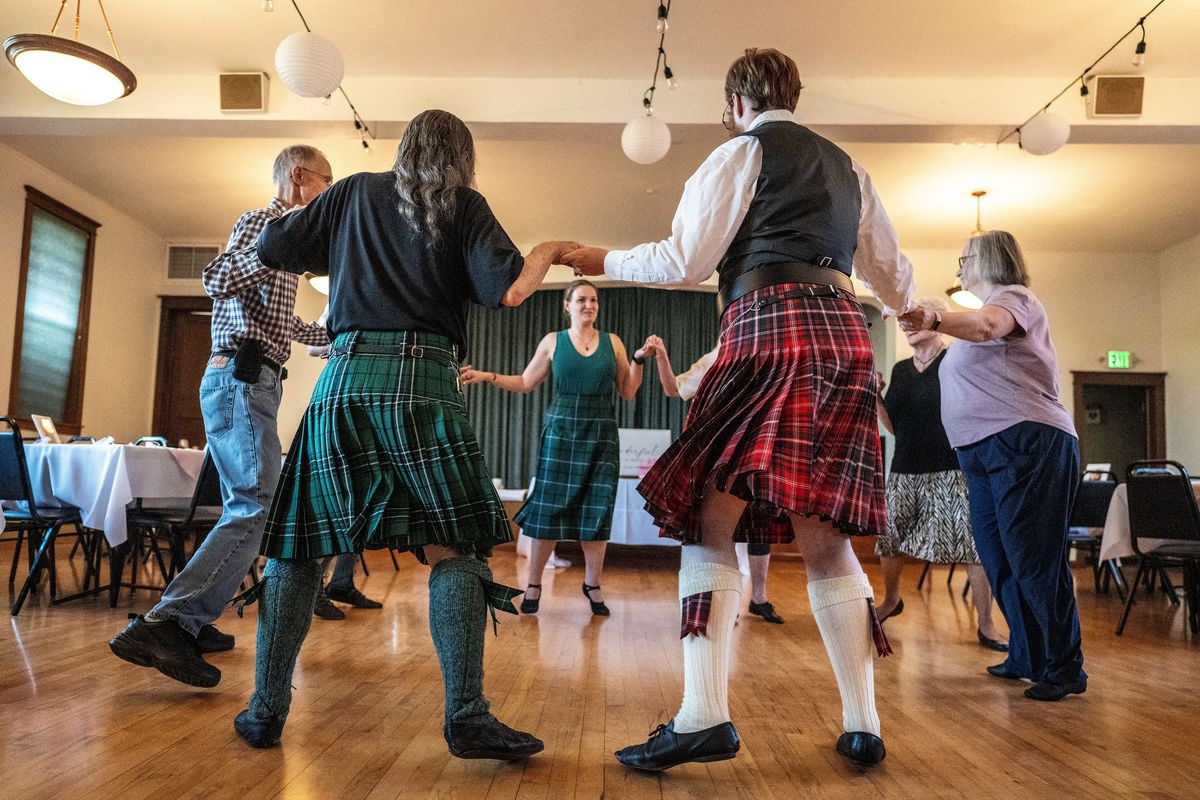Scottish country dance group provides community, cardio and fun

In 2003, when Anna and Peter Guthrie were living in Alaska and looking for a place to retire, they quickly chose Spokane.
While they loved the natural setting, the affordable cost of living and the abundance of health care facilities, for them, the city’s real selling point was dance.
“We came to look at the area because we knew they had a Scottish country dance group,” Anna Guthrie said.
A visit to the social group sealed the deal.
The Spokane Scottish Country Dancers formed as a performance troupe for Expo ’74 and has been dancing ever since. They’re a local affiliate of the Royal Scottish Country Dance Society and meet weekly at Holy Trinity Greek Orthodox Church.
On Thursday evening, there were kilts, ghillies (dance shoes) and the sound of fiddles, but nary a bagpipe was heard.
That’s because while Highland dance features the pipes, Scottish country dance is set to music provided by fiddles and piano.
“This is a social dance,” explained Anna, who is the group’s instructor. “Highland is solo and very precise.”
Scottish country dancing is the traditional social dance form of Scotland. Country dances are done in sets of two or more couples. The dances consist of a sequence of figures with dancers tracing progressive patterns. Traditionally a figure corresponds to an eight-bar phrase of music, and the music varies in tempo from lively reels, jigs and hornpipes to the slow, elegant Strathspey.
As people lined up for the first dance of the evening, “The Reel of the 51st Highland Division,” Peter Guthrie shared its backstory.
The dance was written by Lieutenant J.E.M. ‘Jimmy’ Atkinson in a German POW camp during World War II. He had been captured along with most of the British 51st (Highlanders).
He wrote the reel with a St. Andrew’s Cross as its key formation to symbolize Scotland in adversity. His letter with the dance instructions was confiscated by the Germans.
“The Germans thought the Scottish country dance notations were code and spent the rest of the war trying to decipher it,” said Peter, grinning.
After a brief walk-through without music, the dancers swung into the reel.
Beginners are welcome to join the group. You don’t have to be Scottish or have a partner to be included. Anna teaches newcomers a few basic steps, which are later built upon.
“It’s like Legos,” explained dancer Caleb McDougall. “You have all these different blocks, and you can put them together to build other things.”
McDougall was exposed to Scottish country dance in utero, said his mother, Sharon McDougall, also a member. She’s enjoyed this style of dance since the late ’80s.
“Dance with a pattern made sense to me,” she said.
Brad Buff said he joined the group because his child was interested.
“Then they grew up, but I’m still dancing,” he said. “I like the music, the dancing and the people.”
Caitlyn Auberton has a background in ballet and a strong interest in her Scottish heritage. When she moved to Spokane, she discovered the group while looking for information about the annual Burns Night dinner on the St. Andrew’s Society website.
She was hooked after her first visit.
“It’s fun!” she said. “It’s a lot of cardio and engages your brain with all of the figures–each dance has a different combination.”
Three weeks after joining, she performed with them at the Fall Folk Festival. The group is featured regularly at area heritage and arts events. They will be performing in August at The Highland Games.
Catharine Roth discovered the group at a First Night performance.
“I’d done some Scottish country dancing when I studied in England in the late ’60s,” she said.
As the music of the “J.B. Milne Reel” began, Anna said, “Everybody smiles when they dance this.”
Barbara Bley was one of those smiling.
“This keeps you in shape, helps with memory, and it’s fun!” she said.